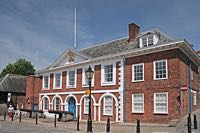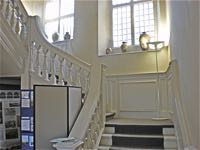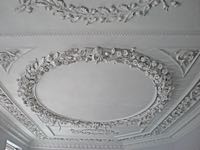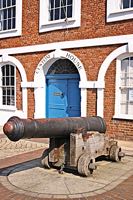
The Custom House
Page updated 17th August 2016
Exeter Memories - Custom House
This handsome building, on the Quay, dates from 1680 to 1681. Previously, excise duty on imports through the port of Exeter were levied from premises in South Street, and before that,Topsham and then Mol’s Coffee House in Cathedral Close. Built next to the Watergate, it was well placed to control the importation of goods and assessing them before they were transported into the city. At the same time, the Quay was isolated from the river with infill, creating a new Quay away from the old city wharf.
Designed by North Devon builder, Richard Allen, The Custom House is thought to be the oldest brick building still surviving in Exeter. The Chamber expended £3,000 on its construction. H. M. Customs and Excise used it until 1989, to monitor goods imported to the Quay for customs duty.
Originally, the arches at the front were open, allowing goods to be stored out of the rain. On the ground floor, to the rear of the front storage area, was installed the King’s Stove, said to be used to burn contraband goods. There is a fireplace with cast iron door and flue in a rear room, but archaeologists are not certain if it is the actual stove.
The building has three fine interior plaster ceilings created by John Abbot of Frithelstock (1639-1727). He was paid £35 for the three ceilings which are some of the finest of their type in the country. One, in the surveyors room, has an octagonal centre piece surrounded by plaster flowers and ribbons and a variety of outer panels. The largest in the main hall on the first floor is adorned with intricate masks, and four serpents with rather strange eyes. The third over the stairwell, is the simplest, and in some ways the most elegant, of the three. Another John Abbot ceiling can be found at Downes House, Crediton, the former home of General Sir Redvers Buller.
Celia Fiennes described The Custom House thus:
".... just by this key is the Custom House, an open space below with rows of pillars which they lay in goods just as its unladen out of the ships in case of wet, just by are several little rooms for Land-waiters, etc., then you ascend up a handsome pair of stairs into a large room full of desks and little partitions for the writers and accountants, its was full of books and files of paper, by it are two other rooms which are used in the same way when there is a great deal of business;"
The work of the custom house
The Port of Exeter includes the Exe Estuary and extends from Teignmouth through to the east of the River Axe, at the Devon and Dorset boundary. Up to 1832, all merchants had to report for clearance, and pay dues, to the Exeter Custom House.
In September 1843, men of the Preventive Service, based at The Custom House, discovered ninety seven, four gallon kegs of foreign spirit that had been sunk near the Fair Way Buoy, Exmouth. Then in April 1844, ninety-four kegs of contraband spirit were taken at Budleigh and conveyed to The Custom House. These two cases indicate how far the jurisdiction of The Exeter Custom House stretched.
The men of The Custom House had a real job to do, catching smugglers and overseeing imports from the Quay.
Things could get very busy if there were a change in the rate of duty. In April 1854, the duty on tea was reduced by 4d per pound, and the custom’s records show that the day after the reduction, £4,630 was collected in duty on tea cleared through the port; it was rare that such a run occured due to a reduction in duty.
Twenty years later, in April 1877, The Custom House officials collected more than £6,200 in four days between April 9 to 12, before duty was increased by the Chancellor. The breakdown of goods cleared from the bonded warehouses was 7,500 gallons of spirits comprising brandy £2,200, whiskey £1,031, and rum £612, wine £108, and tea and tobacco £2,274. There were so many traders trying to remove their goods out of the bonded warehouses that many could not clear in the time, due to the pressure on the custom’s officials.
It was not just wine and spirits, tobacco and tea that passed through Exeter. The Custom House oversaw the importation of coal from South Wales and Sunderland—between 1758 and 1784, the tonnage increased from 4,266 to 17,143 tons.
The Russian Cannon
In the front of the building, are two cannon originally thought to have been used at the battle of Waterloo—they were two of a batch that had been sold to Russia in 1789 to arm their fleet at Archangel. They were returned to England after Napoleon was defeated, as by then they were obsolete. It was intended to use four on the Wellington Memorial, in Somerset. Fifteen were shipped to Exeter Quay in 1819. The committee overseeing the memorial, discovered that they had not been used at Waterloo and refused to take them. After five years of looking after them, the City Council decided to sell them to pay for their storage, but in fact they were never sold. Four were used as bollards at the Quay, and the rest buried.
In the early twentieth century the cannons were excavated and four mounted at the Wellington Memorial. During the Second War the cannon were melted for scrap, leaving only the Exeter cannon surviving. The cannon have since been removed from the Quay side, and mounted and placed in the front of The Custom House.
Sources: Newspapers in the British Newspaper Archive. Archaelogical Investigation of the Custom House by M.F.R. Steinmetzer. The Ports of the Exe Estuary by E. A. G. Clark.
│ Top of Page │





